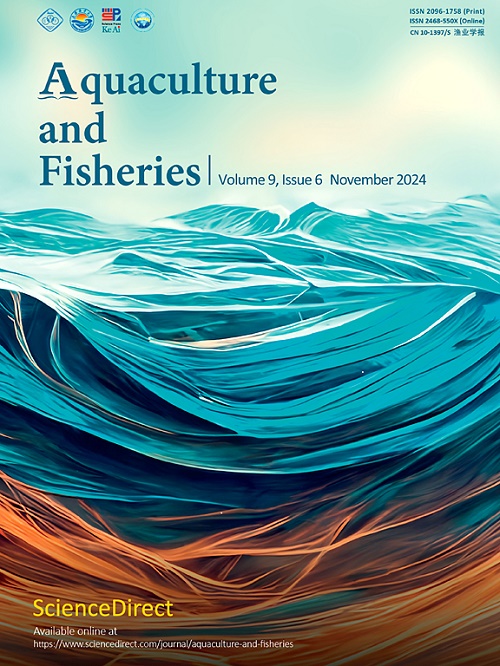从金头鲷(Sparus aurata)中分离出的哈维氏弧菌和副溶血性弧菌的流行率、分子分型、抗生素图谱和组织病理学变化
Q1 Agricultural and Biological Sciences
引用次数: 0
摘要
弧菌科是一种常见的细菌性疾病,影响野生和养殖的海洋鱼类,并在全球造成巨大的经济损失。为了调查养殖鲷鱼弧菌病的流行情况、分子分型、抗生素谱和致病性,在伊斯梅利亚省和塞得港省的不同养殖场随机采集了250只金头鲷(Sparus aurata)。收集的鱼进行临床、死后、细菌学和组织病理学检查。大多数受感染的鱼表现为腹水、出血性肛门突出、胸鳍、背鳍和尾鳍出血、鳃腐烂、头部变薄、皮肤变色,以及口腔和皮肤溃疡。弧菌感染主要发生在夏季(35%)和春季(26%),其次是秋季(22.5%),其中肾脏是最主要的感染器官(45%)。弧菌16s rRNA基因PCR扩增得到663 pb的DNA条带,具有所有分离弧菌的特征。爆破鉴定为哈维弧菌和另一种副溶血性弧菌。自然感染的金头鲷的组织病理学检查显示肝实质轻度至中度空泡变性伴小管肾病和大量肾细胞破坏。脾组织显示局灶性活化的黑素巨噬细胞中心。进行了抗菌药物敏感性试验,其中回收的菌株对新生物素完全敏感,对氨苄西林高度耐药。综上所述,表型和基因型特征的协同作用是弧菌种类诊断的一种有价值的流行病学工具。应执行严格的兽医卫生条例,以控制这类感染,并尽量减少养鱼场使用抗菌药物。本文章由计算机程序翻译,如有差异,请以英文原文为准。
Prevalence, molecular typing, antibiogram and histopathological changes of V. harveyi and V. parahaemolyticus isolated from Gilthead sea bream (Sparus aurata)
Vibrionaceae are a common bacterial disease that affects both wild and farmed marine fishes and causes tremendous economic losses globally. In order to investigate the prevalence, molecular typing, antibiogram and pathogenicity of vibriosis among cultured sea bream, two hundred and fifty Gilthead seabream (Sparus aurata) were collected randomly from different mariculture farms at Ismailia and Port Said Governorates. The collected fish were subjected to clinical, postmortem, bacteriological, and histopathological examinations. The majority of infected fish displayed ascites, hemorrhagic protruded anus, hemorrhages in pectoral, dorsal and tail fins, rotten gills, thinning of the head, discoloration of the skin, besides ulcer in the mouth and on the skin. The prevalence of Vibrio infection mostly was noticed at summer (35%) and spring (26%) then (22.5%) in autumn, where the kidney was the most predominant affected organ (45%). Vibrio 16s rRNA gene PCR extension generated a 663 pb amplified DNA bands that characteristic for all tested vibrio isolates. Blasting identified as V. harveyi and the other V. parahaemolyticus. The histopathological examination of naturally infected Gilthead seabream exhibited mild to moderate vacuolar degeneration of the hepatic parenchyma with tubular-nephrosis and massive renal cellular destruction. The splenic tissues showed focal activated melanomacrophage centers. The antimicrobial sensitivity was carried out, where the recovered strains were completely sensitive to novobiocin and highly resistant to ampicillin. In conclusion, the synergism of phenotypic and genotypic characterization is a valuable epidemiological tool for the diagnosis of Vibrio species. Strict veterinary hygienic regulations should be implemented to control such infections and minimize the antimicrobial use in fish farms.
求助全文
通过发布文献求助,成功后即可免费获取论文全文。
去求助
来源期刊

Aquaculture and Fisheries
Agricultural and Biological Sciences-Aquatic Science
CiteScore
7.50
自引率
0.00%
发文量
54
审稿时长
48 days
期刊介绍:
 求助内容:
求助内容: 应助结果提醒方式:
应助结果提醒方式:


